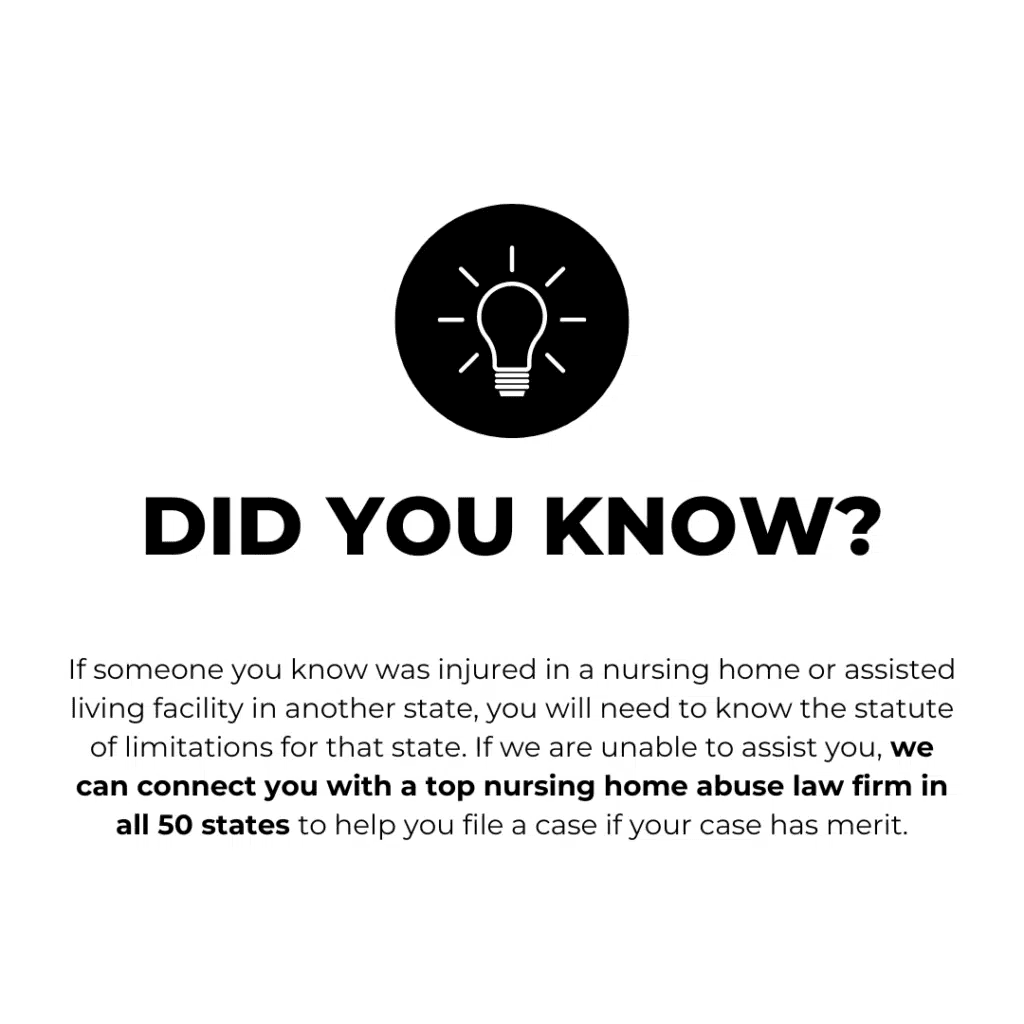
Nursing home abuse and neglect put vulnerable residents at serious risk, leading to malnutrition, dehydration, infections, and preventable injuries. When facilities fail to provide adequate care, residents suffer, and families are left feeling helpless. Lack of supervision, improper medical treatment, and unsafe conditions can result in devastating harm. Understanding the warning signs, knowing your legal rights, and holding negligent facilities accountable are crucial steps in protecting your loved ones. Learn how to take action and seek justice.
November 5, 2024
3 min
Nursing homes are meant to be safe havens for older adults who need extra care and support in their daily lives. However, statistics reveal a troubling reality: many residents in these facilities face various forms of mistreatment, from physical abuse and neglect to financial exploitation. Together, we will dive into the statistics surrounding nursing home abuse, shedding light on the different types of abuse prevalent in these settings and why they occur. From physical harm to emotional distress, sexual abuse, financial exploitation, neglect, and even elder abandonment, each aspect of abuse highlights the urgent need for change. By understanding the challenges faced by nursing home residents and the factors contributing to their vulnerability, we can work towards creating safer, more compassionate environments for our elderly population.
It is a common misconception that abuse and neglect require an intent to harm a resident. Abuse and neglect occur any time a nursing home resident is deprived of care or services that are essential to their well-being. The most common injuries that result from nursing home abuse and neglect are:
The vast majority of instances of abuse and neglect are caused by understaffing at the nursing home.
Physical abuse in nursing homes is a serious breach of trust and dignity, where vulnerable residents suffer harm from those who are supposed to care for them. This abuse can range from rough handling and unnecessary restraints to outright assault. This causes not only physical pain but also emotional scars. It undermines the safety and security that nursing homes should provide. Solving this problem requires more than just watching closely and enforcing rules. It needs a change in how we view and treat the elderly, prioritizing kindness and respect.
Every case of abuse highlights the urgent need for major changes to protect nursing home residents and ensure they are treated with dignity and safety. This is a concern echoed by statistics that reveal the prevalence and severity of physical abuse in these facilities. Shocking statistics reveal the scope of the issue:
Emotional abuse in nursing homes is a devastating betrayal of trust, where residents endure psychological harm from those entrusted with their well-being. This form of abuse can manifest in various ways, including verbal insults, intimidation, and manipulation. Emotional abuse can lead to residents feeling scared, worthless, and isolated. Such mistreatment not only undermines residents’ mental and emotional health but also gets rid of their sense of safety. Addressing this issue requires more than just enforcing rules. It demands a fundamental shift in how we perceive and treat the elderly, emphasizing empathy and compassion in caregiving practices.
Sexual abuse in nursing homes involves various inappropriate sexual acts and behaviors inflicted upon elderly residents who can’t give consent or defend themselves. It’s often hidden and brings feelings of shame. This abuse causes both physical harm and deep emotional pain, leaving lasting scars on victims. The prevalence and impact of sexual abuse in nursing homes are underscored by concerning statistics that reveal the extent of this distressing issue:
Financial exploitation in nursing home residents is a serious breach of trust, where vulnerable individuals suffer various forms of financial abuse from those in positions of power. This abuse can include theft, coercion, and fraud, with abusers taking advantage of their access to residents’ money and assets. Whether it’s misusing credit cards or tampering with legal documents, these actions not only lead to financial losses but also threaten the independence and safety of elderly residents. Preventing and detecting financial exploitation in nursing homes requires careful monitoring, strong oversight, and legal protections to ensure residents’ financial security and uphold their dignity. Staggering statistics of financial exploitation in nursing homes include:

Neglect in nursing homes is a serious and often overlooked issue where residents fail to receive the necessary care and attention they need. This can include insufficient medical care, poor hygiene, inadequate nutrition, and lack of social interaction. Such neglect can lead to severe physical and emotional harm, exacerbating health problems and diminishing the quality of life for elderly residents. Addressing neglect requires stringent oversight, adequate staffing, and a commitment to maintaining high standards of care to ensure that all residents live in a safe and supportive environment.
Elder abandonment in nursing home residents is a severe form of neglect where family members or caregivers desert elderly individuals, leaving them without necessary care and support. This abandonment can lead to severe physical and emotional distress, as abandoned residents may be left without basic needs, medical attention, or social interaction. The isolation and lack of care can exacerbate existing health conditions and significantly reduce their quality of life. Addressing elder abandonment requires strict regulations, comprehensive support systems, and community awareness to ensure that all elderly individuals receive the care and dignity they deserve.
Inadequate staffing in nursing homes can make it hard for caregivers to meet residents’ needs. This can lead to rushed care, missed tasks, and less attention to what residents require. As a result, residents might be at higher risk of abuse and neglect because caregivers may not notice signs of mistreatment or help when needed. Also, understaffing can make caregivers feel stressed and burned out, which might make them more likely to act abusively or neglectfully. It’s crucial to fix staffing problems in nursing homes to keep residents safe and cared for properly.
Staffing challenges can contribute to concerning statistics such as:
Often, nursing home staff do not get proper training, which can lead to serious consequences, including death. Without enough training, staff may not have the skills needed to handle complex medical conditions, respond to emergencies, or care for residents with special needs like dementia or mobility issues. This lack of knowledge can cause serious mistakes with medications, improper use of medical equipment, or missing important health signs, all of which can be fatal. It’s crucial to ensure that all nursing home staff receive thorough and ongoing training to protect the health and lives of vulnerable residents.
These statistics underscore the urgent need for action to protect the most vulnerable members of our society and ensure that nursing homes fulfill their mandate of providing safe, compassionate care. Addressing nursing home abuse requires a multifaceted approach. It involves implementing stricter regulations, improving staff training, increasing oversight, and fostering a culture of empathy and respect within care facilities. It is imperative that we come together to address the root causes of nursing home abuse and ensure that all individuals, regardless of age or ability, receive the care and respect they deserve. Only through concerted efforts can we create a future where nursing homes are truly places of safety, comfort, and compassion for our elderly population.
Disclaimer: This information is provided for informational purposes only. Nothing in this article should be construed as providing legal advice or the creation of an attorney client relationship. Laws are updated frequently and change from state to state. If you desire legal advice, you can contact Michael Hill Trial Law at www.protectseniors.com, send an email to info@protectseniors.com, call (800) 659-2712 to begin an investigation, or contact another attorney.